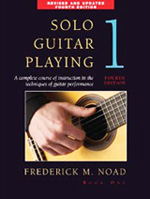Guitar Fingerpicking Tips – Learn How to Fingerpick
Guitarists that are first beginning to learn the art of how to fingerpick (guitar, banjo, or any stringed instrument) will definitely find it as a challenge. But, the beginning guitarist will also find it as one of the most rewarding endeavors ever undertaken. To facilitate the process, you’ll find here some helpful acoustic guitar tips about fingerpicking and information about what could be considered as the best finger picking book written.
Whether you play a classical guitar or an acoustic, proper guitar fingering techniques are essential. Learning such techniques opens up a whole array of different types of music you can play, even complicated pieces you never thought possible.
An Excellent Book for Learning Guitar Fingerpicking Techniques
Although you’ll find some useful guitar playing tips on this website, I found Frederick Noad’s instructional manual Solo Guitar Playing one of the best books ever as a learning aide. Solo Guitar Playing is a fingerpicking book that completely covers the technique of how to fingerpick. The book is available for purchase for under $14 on Amazon’s website (with the accompanying CD the cost is about $27) and is highly recommended. If you click on the link above you will see reviews of the book, all of which are 5 star ratings.
Frederick M. Noad is well known for his programs on public television and is a scholar of the guitar. His book is well organized and it takes you from simple finger techniques with accompanied exercises and songs to increasingly more difficult guitar pieces. Therefore, I highly recommend purchasing Noad’s book. It is inexpensive and comes with a CD that demonstrates the exercises and songs presented in each chapter.
Beginning to Fingerpick: Naming the Fingers
Fingerpicking is basically a playing technique in which all of your fingers are used to pick the individual guitar strings (excluding the pinky finger) instead of using a flat pick. Using a flat guitar pick—held between the thumb and index finger—can be used in combination with the middle and ring finger, but you than become somewhat limited because the thumb and index finger, in essence, become one from having to hold the pick. Therefore, you basically loose a picking finger, which may limit you in playing certain songs that require all your fingers.
The fingers of the right hand are traditionally named by the Spanish words pulgar, indicio, medio, and anular, which correspond to the thumb, index, middle, and ring finger, respectively. Any music book that notates fingerpicking will usually include the term (or letters) “PIMA”, which is the first letter of each of the Spanish words above. One of these letters (or a combination of letters if it is a chord) is typically shown above the note in the musical notation and designates what finger to use to stroke that particular string.
Rest Stroke vs Free Stroke
The rest stroke is the most fundamental technique for playing successions of single notes on the guitar. Basically, to execute the rest stroke, the tip of the finger touches the string to be played. As you press the finger down across the string, the edge of the nail catches it and causes it to sound. The finger than comes to rest on the next string.
To play the next successive note, you will execute it in the same manner as explained above but with a different finger. You will never play successive notes with the same finger of the right hand. Always alternate the fingers, which typically will be the index and middle. So, if you begin with the index finger, the next stroke will be done with the middle, and the third note sounded will be made with the index.
The free stroke is similar to the rest stroke with a slight variation. Rather than the finger resting on the next string after executing the stroke, it moves somewhat laterally and slightly upward and away from the guitar. The free stroke is typically used when a rest stroke would damp the adjacent string when it is meant to continue sounding.
As previously mentioned, Frederick M. Noad’s fingerpicking book “Solo Guitar Playing” thoroughly covers and demonstrates these techniques and provides invaluable guitar fingerpicking tips throughout. It is one of the best books written for this style of guitar playing.

